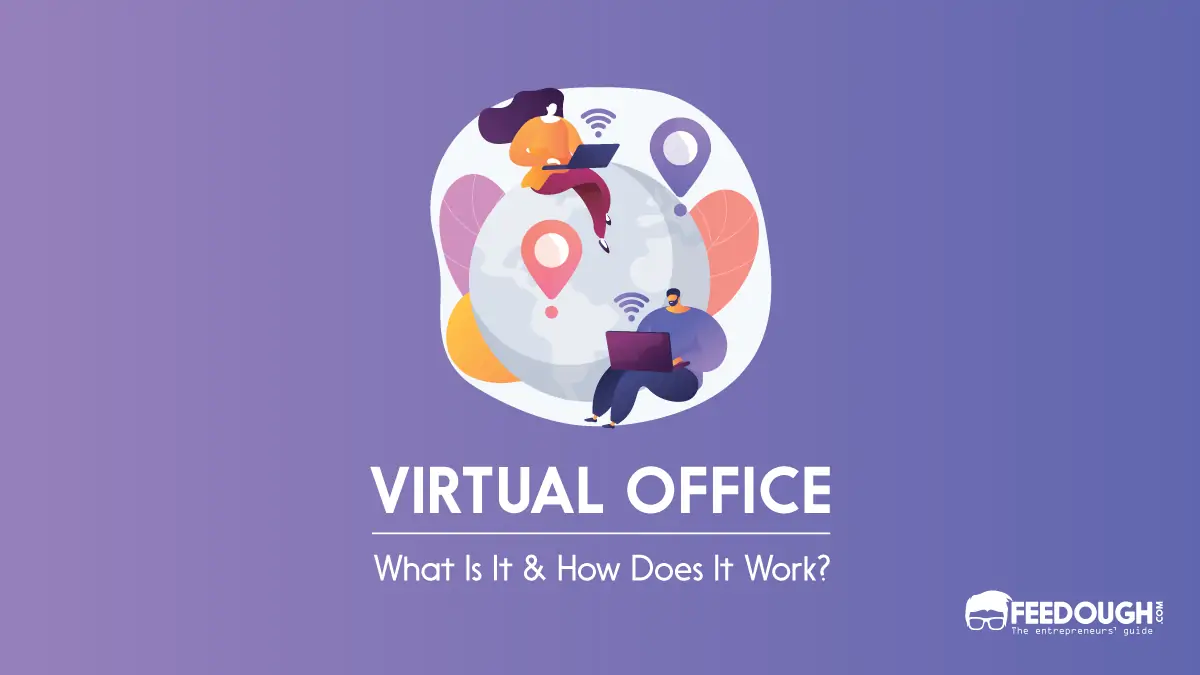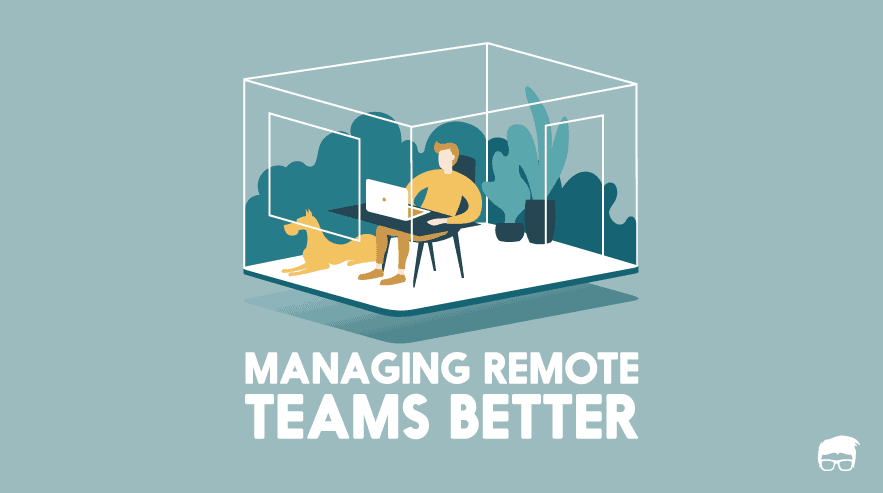The word virtual means ‘not physically existing,’ and team means ‘a group of people with common goals.’ Therefore a virtual team is the one that works for a common objective without any physical contact.
The remote working trend might make one think of the virtual team as a contemporary concept. However, the origin and use of virtual teams can be dated back to the sale of PCs in the 1960s, when a team’s working didn’t require the physical presence of the members at one place. Later the popularity of cellular phones, voicemails, and eventually the internet and World Wide Web made way for a virtual working setup.
To understand better, let’s look into Virtual Teams: definition, characteristics, types, working, advantages, disadvantages, and examples.
What Is A Virtual Team?
A virtual team is a group of people that collaborate operate digitally to achieve a common objective without being present in the same physical space.
In simple words, a virtual team:
- Is a group of people: A team comes into existence through its people. These people bring various abilities, talents, and efficiency levels to the team. Individual creativity and perspectives of different people contribute to the entire group’s working as a united team.
- That collaborate without being present in the same physical space: A virtual team is not physically present at a specific place. It constitutes people separated geographically hence called ‘dispersed or remote teams.’
- And operate digitally: Members of a virtual team are located in different places. Therefore they coordinate and work together using digital technology. The entire business takes place in the virtual mode using online communication platforms, team management software, and project management tools.
- To achieve a common objective: Althoughthe people working in a virtual team are located in different areas, they connect virtually to work together towards a common goal. They may carry out different functions, but they all relate to a common objective.
What Are The Types Of A Virtual Team?
Let’s get a closer look into the different formats of a virtual team by understanding their respective objectives:
- Networked Teams- These teams usually consist of people inside and outside the organisation. The members bring expertise in various fields to achieve their clients’ goals. The group adds and removes members when the roles and responsibilities are fulfilled. Companies usually form these teams to rope in the expertise of fields that it lacks.
- Parallel Teams- These teams consist of people within the organisation. These teams benefit from the diverse experiences and work skills of their employees. Different departments within an organisation collaborate and give recommendations to address each other’s inefficiencies to succeed.
- Product Development Teams- These teams are comprised of cross-functional workers of the organisation and experts from outside the organisation. They are primarily devoted to the research and development wing of the organisation and continuously improve their offerings.
- Production Teams- These teams comprise employees who work continuously for the business’s day-to-day projects. They are employed indefinitely and are allocated new tasks after completing older tasks fulfilling their overall objective. Marketing firms, designing brands, etc., are examples of production teams.
- Freelance Teams- These teams are hired when necessary and comprise creative workers like editors, designers, writers, developers, etc. These teams are hired temporarily to add aesthetic and visual value to the company’s offerings and thus maximise profits.
- Service Teams- These teams comprise people located in different time zones and ensure the service is active for 24hours. Customer care and support teams of most organisations are examples of service teams. They are active throughout the day to address customers’ grievances and resolve their complaints.
- Action Teams- These teams are formed to resolve an urgent issue with the help of experts. They are immediately dissolved after the resolution of the problem. These experts give recommendations and execute them to ensure smooth business.
- Management Teams- These teams comprise general administrative and managerial heads of different branches of an organisation. They are permanent and ensure teamwork and success globally, aligning all the wings in the right direction.
- Information System Development Teams- These teams complement the central organisation by completing the smaller tasks. They are permanent and closely complement the business of the parent firm.
- Hybrid Teams- These teams may be temporary or permanent and combine on-site and virtual team members sharing individual roles and responsibilities.
How Do Virtual Teams Work?
A virtual team undertakes the business remotely from different locations. To get insights into the dynamics of a virtual team, we first need to understand the components of a virtual team.
- Purpose: The purpose serves as fuel for a virtual team. This final objective inspires different team members to perform their tasks to their best. Every team member is held responsible for a specific job, and fulfilling these independent jobs fulfils the ultimate purpose. Therefore a clear-cut goal provides clarity to the team and guides the members’ day-to-day activities.
- People: Although technology is a significant feature of a virtual team, its people are still the most important. The members work on two levels, individual and group levels. Individual-level relates to their independent working using their unique creativity and talents. In comparison, group-level relates to their working with other team members. It is vital to reduce gaps at both levels to maximise productivity and harmony among the members.
- Technology Links: Technological links addressa virtual team’s lack of physical presence. These links are the essence of a virtual team and ensure continuous hassle-free interactions among the team members. Moreover, these digital tools are the only trusted sources for team building, work planning, and decision-making in a virtual team. Emails, videoconferencing, project management software, etc., are some examples of technology links used by remote teams.
- Work Schedule: Team members of a virtual team are geographically dispersed. Therefore, balancing all team members’ time zones and work schedules is essential. Coordination is necessary for a virtual team to ensure smooth working and maximum productivity.
Advantages Of A Virtual Team
Let’s look into some merits of virtual teams in a business. It comes helpful in:
- Saves Costs: A virtual team works remotely. Therefore the expenses relating to rent, utilities, travel, and other overheads of the office spaces are a direct saving for the business. A report by Cisco suggests that the company annually saves $277 million by adopting a virtual working model. Moreover, a virtual team also maximises profit due to lower production costs in employee-related expenses and fixed costs.
- Attracts Wider Talent: Virtual teams work beyond physical boundaries, enabling businesses to hire people from across the globe. It ensures a wider pool of talented and competent people making valuable contributions to the company. Organisations can also benefit from the expertise and perspectives of the people beyond physical reach.
- Creates New Opportunities: The virtual work setup creates umpteen work opportunities for people facing physical or social challenges. No work process or task in a virtual team requires physical presence; therefore, opening gates for many deserving candidates who otherwise won’t be able to work on-site.
- Increases Productivity Levels: By adopting the virtual work setup, a business cuts down the time for commuting to the workplace. This elimination of travel time gives workers more time to focus on their job. Moreover, research by Standford Business shows that productivity increases by 13% as employees can work throughout their shift and concentrate better from their homes.
- Improves Work-Life Balance: A research shows that virtual employees are 29% happier than their on-site colleagues. Working from home enables people to complete the given tasks on time or even before the scheduled time. The workers end up saving time for their personal lives, which is why they are happier and satisfied in their job.
Disadvantages Of A Virtual Team
Now let’s look into some demerits of a virtual team. Businesses might not prefer them as they:
- Involve Technology Costs: Effective work operations in a virtual team require the support of multiple technology platforms. Multi-media platforms are necessary for videoconferencing, messaging, planning, designing, collaborating, etc. All these platforms involve high costs of installation, training, and maintenance. Moreover, the frequent updates and evolution in technology add to these costs of the business.
- Lead To Conflicts: Cultural differences in a virtual team often lead to conflicting interests. The differences in social settings lead to different perceptions of the same thing, leading to miscommunication and conflicts. This misinterpretation leads to disputes and obstructs operations.
- Involve Security Risks: Digitalisation brings with it a crucial security risk. Companies employing virtual teams exchange and store their work resources in the virtual ecosystem, prone to viral threats and other malpractices. These potential threats may prove costly as they can block the very lifeline of the business.
- Socially Isolate The People: Humans are social beings, and the lack of physical interactions may reduce efficiency. Interactions in a virtual team are mostly job-oriented, without any informal communication. It leads to monotony and severely affects employees’ morale as they do not get an interpersonal connection with their peers.
Case Examples Of Successful Virtual Teams
The speed of technological advancements at present is unmatchable. Digitalisation has seeped in to make its way into the business ecosystem at a rapid pace. Adopting online ecosystems and virtual teams enables firms to reach greater heights.
Let’s get insights into some companies evolving with virtual work setups.
Adobe
Adobe has combined creativity with technology for their employees in the digital workspace. Moreover, it has embraced the hybrid and remote work setup in many ways by adopting.
- Crucial Digital Transformation- The company has heavily invested and developed its technological abilities. It improves the employee experience right from induction to collaboration and career growth. Moreover, the enhanced digital links will build a stronger community for a more productive workforce.
- Flexibility- The company has given greater flexibility to its employees in choosing the mode of working as may be the best for the individual, the team, and the business.
- Expansion Of Remote Working- The company believes in in-person interactions but still acknowledges the need for remote working. It has kept feasibility, the urgency of business, and the impact of work in mind to curate the criteria for remote working and effectively rolled out the policy with time.
Spotify
Spotify has welcomed the modern working norms and given up the office work culture altogether. The following core beliefs drove them towards this transformation.
- Only Work Matters- The company believes that the work one does matters and not the place of work.
- Better Work-Life Balance- The company believes remote setup would support the better life balance and not only retain the existing employees but rope in better talents.
- Effectiveness- The company empowers its employees by giving them the freedom to work from wherever they want. This freedom provides a sense of belonging and boosts the employees’ energy and productivity.
- Better Opportunities- The company believes that a dispersed workforce results in better networking and growth opportunities benefiting from global talents and resources.
Bottom-Line?
The global pandemic crisis and adoption of digital technology in day-to-day lives have undoubtedly made way for online learning and work setup.
Needless to say, virtual teams have stood the test of time and delivered efficient outcomes, therefore making remote working a norm today.
Moreover, the US Bureau of Labor Statistics report suggests that 22% of US workers work remotely, with 505 of the total workforce working virtually in some capacity.
It would not be wrong to say that virtual teams are a new reality, but planning and building them remains a hurdle for many organisations. Therefore the inadequacies should be acknowledged to reap the umpteen benefits of a virtual setup.
A fervent reader, research maniac, and a go-getter with a knack for opinionated content. Janvi has actively contributed to educational institutions, startups, and non-profit organisations through her structured and expressive writings. Often found socialising, playing with dogs, and photographing.








